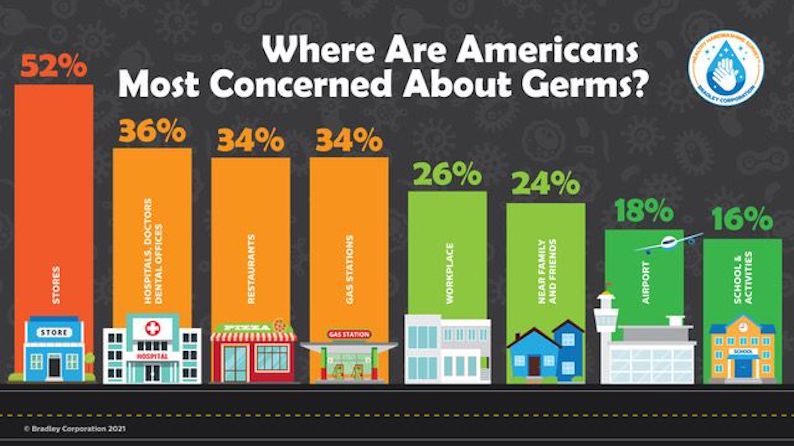 Cleanzine: your weekly cleaning and hygiene industry newsletter 26th June 2025 Issue no. 1168
Cleanzine: your weekly cleaning and hygiene industry newsletter 26th June 2025 Issue no. 1168
Your industry news - first
The original and best - for over 20 years!
We strongly recommend viewing Cleanzine full size in your web browser. Click our masthead above to visit our website version.
Americans continue to use public washrooms during pandemic but want touchless fixtures
 According to a national survey by Bradley Corp., half of the US population have continued to use public washrooms throughout the pandemic. Just 13% said they completely avoided using them while 50% visited them just as they always had.
According to a national survey by Bradley Corp., half of the US population have continued to use public washrooms throughout the pandemic. Just 13% said they completely avoided using them while 50% visited them just as they always had.
Another 37% said they were uncomfortable about using them but had, at times, done so when when necessary.
The most common places Americans used these away-from-home facilities were stores, restaurants and the workplace. The majority of users took precautions to reduce their likelihood of coming into contact with germs. Some 63% had hold of a paper towel as a protective barrier when they operated the flush and faucet handles or reached for door handles. Another group employed their foot to flush the toilet or opened and closed doors with their backside.
The annual Healthy Handwashing Survey from Bradley Corp. queried 1,050 American adults regarding their public washroom usage, handwashing habits and concerns about the Coronavirus and flu. Participants were from around the country and were evenly split between men and women.
Since Americans have relied on evasive measures to avoid germs, it is not surprising that 84% believe it is important to have touchless fixtures. In fact, nearly 70% say they are more likely to return to a business that has touchless features in the washrooms. On the other hand, 56% have a negative impression of a business that doesn't have touchless fixtures.
When it comes to which fixtures Americans prefer to be touchless, the toilet flusher, faucets and entrance doors top the list.
"Touchless fixtures add a significant level of comfort for Americans when they're out and about and need to use a public restroom," says Jon Dommisse, director of strategy and corporate development for Bradley Corp. "We've all become more cognisant of potentially germy touch points so eliminating an area of concern is another way we can help resume our normal lives again."
The Healthy Handwashing Survey, which was conducted in January 2021, found that 86% of Americans are more conscious about coming in contact with germs as a result of the Coronavirus.
That concern has led to a spike in handwashing and hand drying. The survey revealed that nearly 90% are washing their hands more frequently or more thoroughly as a result of the Coronavirus. In terms of frequency, 57% are sudsing up between six to 15 or more times a day and 73% are drying their hands more frequently or more thoroughly.
That is significant because hand drying is an important step in the handwashing process. The Centers for Disease Control and Prevention (CDC) explains that: "Germs can be transferred more easily to and from wet hands; therefore, hands should be dried after washing."
Overall, Americans correctly believe handwashing is a better germ-fighter than hand sanitiser, with 61% understanding that their hands are less germy after washing with soap and water than after using hand sanitiser - a fact supported by the CDC. For times when soap and water are not available, the CDC says that using hand sanitiser is a good, second option for hand hygiene.
"Handwashing remains one of the easiest and most effective ways to stay healthy and reduce the likelihood of spreading germs or viruses to others," adds Jon Dommisse. "When you pair soap and water with vigorous and thorough scrubbing, you're literally removing and sending bacteria and germs down the drain."
22nd April 2021







